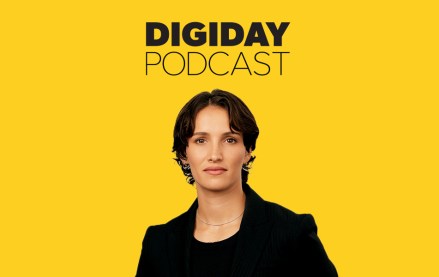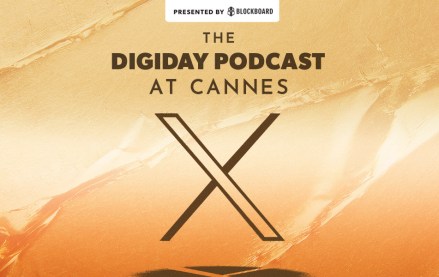‘More volatile now’: Digiday editors share top takeaways from 2023

Subscribe: Apple Podcasts • Spotify
This year was another one for the advertising and media history books, but not for the ways that marketers and media execs hoped for at the start of 2023.
Brands’ advertising budgets never quite found their footing and the competition for ad revenue only got steeper. On top of that, the platforms are no longer reliable places to drive traffic or revenue but competing with their scale is a losing game. Plus generative AI is quickly finding its way into virtually every facet of the industry — for worse or better.
In this final episode of the year of the Digiday Podcast, senior marketing editor Kristina Monllos and senior media editor Tim Peterson join co-hosts Kimeko McCoy and Kayleigh Barber to discuss some of the top trends from the past year and which challenges and opportunities are expected to continue in 2024.
Below are highlights from the conversations, which have been lightly edited and condensed for clarity.
Will scale prevail?
Barber: [Something] that really stuck out to me this year… is this end of consolidated or scaled media plays to try and compete with platforms. It’s something that came up in [Digiday senior media reporter] Sara Guaglione and my coverage of the rumors of BuzzFeed selling off Complex, but in that, there is a lot of talk around digital media companies that were once reliant very heavily on social platforms for traffic and ad revenue … they are seeing a lot less money and audience coming from those areas. And the initial plan was to try and compete for that attention or that ad revenue from the platforms by scaling up and scaling big. But I think this past year showed that that’s not really working as well as they once thought. And this is something I expect to see more next year as well, [publishers being] less focused on scale and more focus on franchisable, niche media and assets that are unique in that way.
Peterson: [The move away from scale] seems largely concentrated to web publishers. On the TV and streaming side of things, scale is still the name of the game to the point where you have a lot of these streaming services now bundling their services together just because they need scale, especially on the ad-supported side of things.
Volatility in 2024
Peterson: What I’ve heard from everyone is how volatile budgets are. Now, that’s not entirely new information. Budgets have been volatile for a few years now. But there were some [execs] who were saying, “No, budgets are more volatile now than at any point in my career.” There were at least two who made that claim and expect it to be the case next year.
That’s affecting all areas of the ad market, from what I can tell, but including traditional TV. Typically traditional TV is a bit more insulated. It has the upfronts and … upfront commitments kind of lessens the volatility to an extent. But everyone that I’m talking to right now is saying, “No, even traditional TV.” A lot of the hesitance to commit in the upfront this past year and likely next year is because there’s just not that level of comfort with these long term commitments.
Barber: [This is] something that we had discussed at the end of last year and beginning of this year around the lack of visibility. Especially from the CRO perspective of digital media companies not being able to predict a quarter until you’re in it. It does seem like that’s the persisting nature of the business and I think unfortunately the reality at least for a while.
Performance vs. brand awareness
McCoy: [There is this] concept that [marketers] shell out for performance to get the sales to prove [themselves] to the CFO, but in the long run, you end up just shelling out more to boost brand awareness [because] everybody has forgotten your brand.
Monllos: I don’t envy anyone in that position where it’s like you are having to fight for every dollar. That’s gotta be tough. But at the end of the day, you can’t only do performance [marketing]. It doesn’t work. You have to give people a reason to care about your brand. There has to be that affinity. We’re not in 2008. It’s not just about storytelling over linear TV, but there does have to be a connection that people feel to a brand. And a lot of that isn’t as important right now for a lot of marketers and that can hurt.
Death knell for Twitter
McCoy: There’s also been a large slew of brands that have left [X] in terms of community and in terms of ad spend. We’ve seen IBM, Apple, CNN, I think Disney even pulled out as hate speech, bots and things like that started to overrun the platform.
Monllos: We’ve seen this ebb and flow with Twitter, where there’s been this expectation that this is it, this is the end. We keep waiting for an actual end to things and most recently, having Elon Musk in an interview with The New York Times, telling Bob Iger to “F himself”, I mean, I don’t really know how [X CEO] Linda Yaccarino can repair these relationships with those brands. I think it gets to a point where it’s just impossible.
If you talk to media buyers [and] you ask them about Twitter, a lot of the time what you’ll hear previously is, “Twitter had such a great team.” And for the big events, that’s where you wanted to be. People were spending time on there; it made sense for brands to be there … [but] you don’t have the team anymore and you have a lot fewer people on the platform. And then what is on the platform is not brand safe a lot of the time.
More in Podcasts

How TikTok’s ‘The Secret Lives of Mormon Wives’ landed on Hulu, with Select Management Group’s Danielle Pistotnik
The talent manager and executive producer of “The Secret Lives of Mormon Wives” joined the Digiday Podcast to break down the process of the reality show finding a home on Hulu.

Digiday Podcast at Cannes: Former Bachelorette Rachel Lindsay makes the case for creators
Between panels and parties, creators are looking to get face time with ad execs, brand marketers and partners like Spotify. However, rather than coming to the Croisette to strike deals, they’re playing a long game.

Digiday Podcast at Cannes: From center stage to closed doors, inside X’s quiet Cannes strategy
Once a Cannes hotspot, Twitter Beach is no more. In this episode, we explore X’s quiet retreat from the Croisette—and why no one’s talking about the TikTok ban either.








